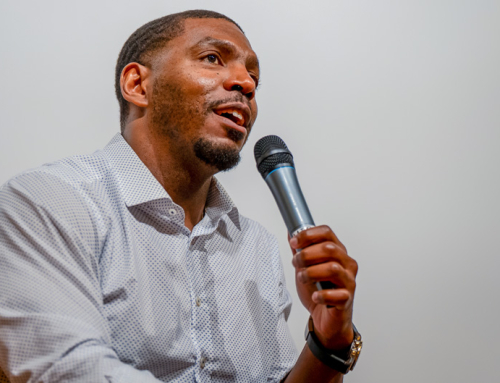Ten years ago, Professor Joseph B. Treaster led The New York Times’ coverage of Hurricane Katrina, one of the worst disasters in American history. Professor Treaster, who had been covering hurricanes for years, was one of the few reporters from a major news organization in New Orleans when the storm hit in late August, 2005 and he stayed with the story for days, working nearly around the clock, scavenging food and water, catching naps on a cot in the emergency operations center at City Hall.
As Professor Treaster tried to get into New Orleans, the airport was closed and the roads were jammed with cars fleeing New Orleans. He managed to drive against the traffic and dodge the police and road blocks and got to the Superdome in downtown New Orleans as night was falling and the first winds of Hurricane Katrina were being felt.
Professor Treaster found the superintendent of police and then rode out the storm inside the emergency operations center in City Hall. Below is the story of his harrowing drive into New Orleans with comments by The Times.
———————————————————————————————————————————————————-
Joe Treaster, who has been racing hurricanes for Times readers for many years, made sure that on the Monday morning the storm hit we were the rare newspaper with a story from New Orleans itself. As thousands scrambled to escape the area before sundown the day before, Joe drove alone, from Mississippi, into the city. The locals thought he was crazy.
In the following days, running out of water and food, Joe hunkered down in New Orleans to show readers from close up the devastation and desperation in the flooded city. Here is his account of his harrowing trip to beat the hurricane into New Orleans — a pretty good example of the dangers and frustrations our correspondents in bad places face:
Gulfport, Miss., a sleepy little port city with sailor bars and tattoo parlors, seemed to be in the cross-hairs of Hurricane Katrina.
I got there around noon on Saturday, Aug. 27, more than 36 hours before the storm was expected. For the first time in years of covering hurricanes and other natural disasters, I arrived with time to spare.
My first stop, after a quick look around town, was a mom and pop bookstore. The owner, nursing a plantation-size hangover, sold me a map of Mississippi and charmed me with tales of Gulf Coast nightlife. He recommended ample quantities of crab meat as a cure for almost everything. As for Hurricane Katrina, he said he did not know whether to take the storm seriously. “There have been so many false alarms,” he said.
Visit http://www.nytimes.com/2015/08/25/insider/september-13-2005-the-hard-road-to-the-big-easy.html to read the rest of this article.
Here are some of Professor Treaster’s Katrina stories:
Powerful Storm Threatens Havoc: http://www.nytimes.com/2005/08/29/us/powerful-storm-threatens-havoc-along-gulf-coast.html
At first it looked like New Orleans had been spared: http://www.nytimes.com/2005/08/30/us/escaping-feared-knockout-punch-barely-new-orleans-is-one-lucky-big-mess.html
But within a day, flood waters covered much of New Orleans: http://www.nytimes.com/2005/08/31/us/nationalspecial/new-orleans-is-now-off-limitspentagon-joins-in-relief-effort.html
The Superdome: http://www.nytimes.com/2005/09/01/us/nationalspecial/superdome-haven-quicklybecomes-an-ordeal.html
The Day After: http://www.nytimes.com/2005/08/31/us/nationalspecial/lifeordeath-words-of-the-day-in-a-battered-city-i-had-to-get-out.html
The Situation Worsens: http://www.nytimes.com/2005/09/02/us/nationalspecial/local-officials-criticize-federal-government-over-response.html






